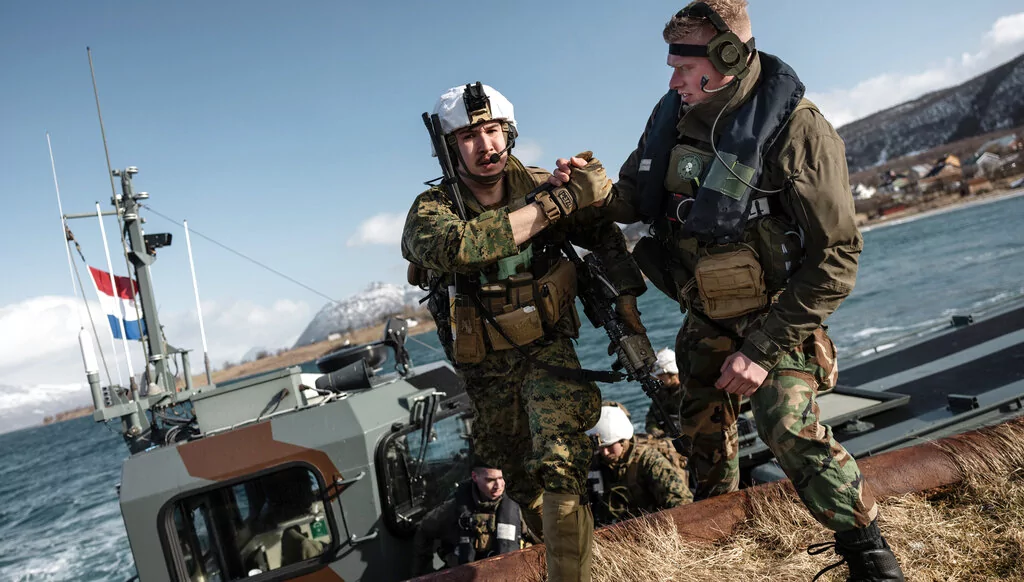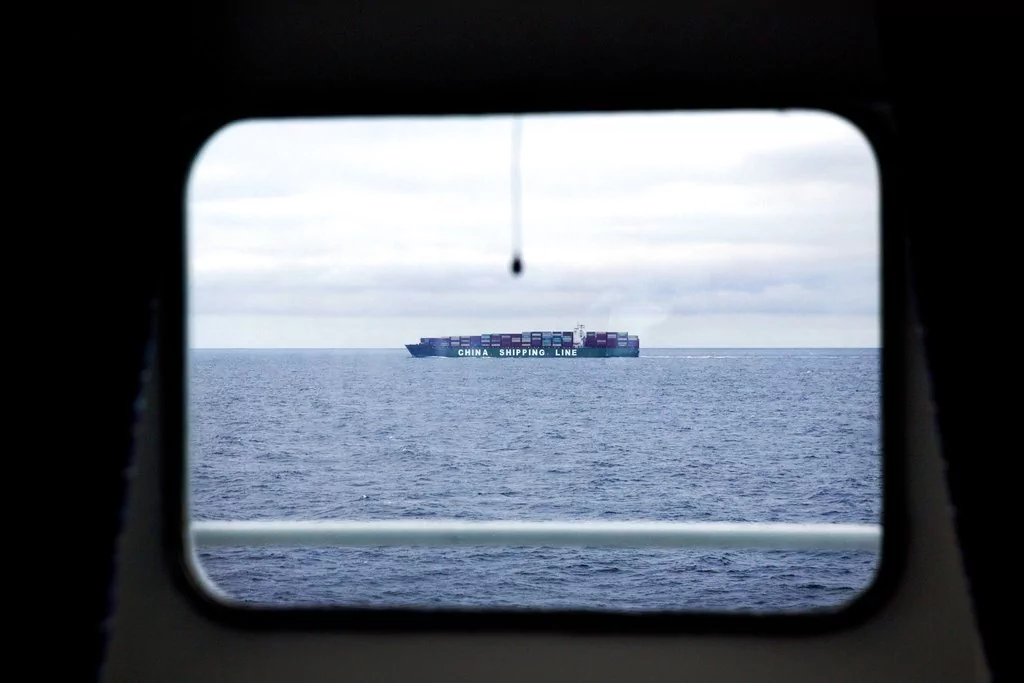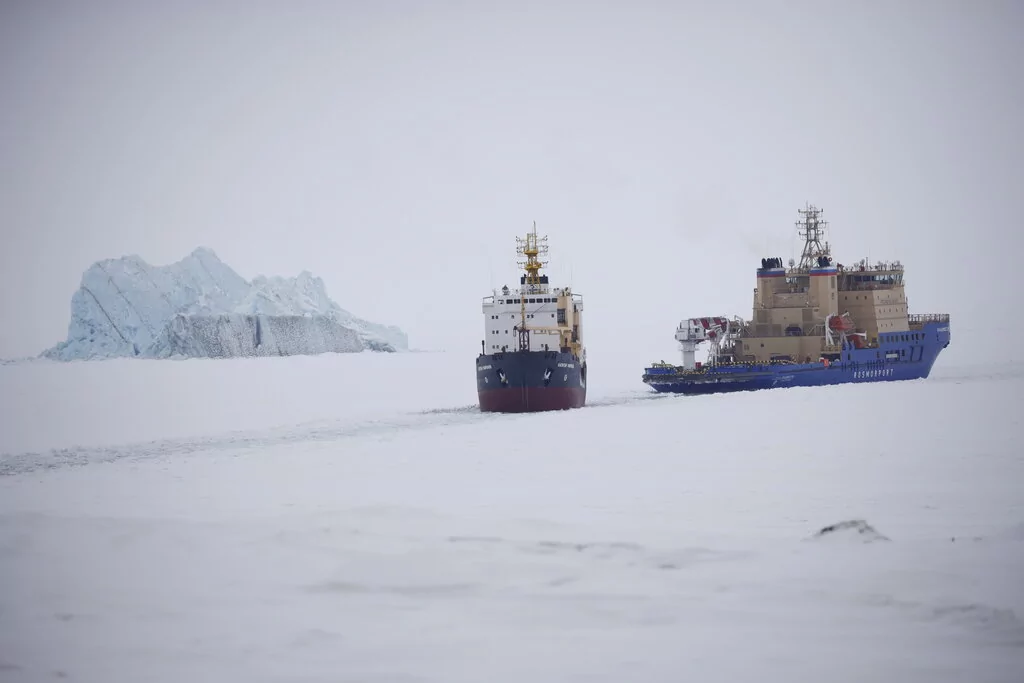
The Arctic was once defined by its lack of potential conflict — encapsulated in the saying “high north, low tension.”
Countries that struggled to cooperate closer to the equator have, for decades, found diplomacy more relaxed among the icebergs, where military considerations took a back seat to environmental research and shipping policy.
Russia’s invasion of Ukraine has shattered that calm. A polar defense race is underway as the United States and its NATO allies become increasingly skeptical of rival powers’ operations in one of the world’s frostiest regions.
The next ‘cold’ war?
The Department of Defense published its latest “Arctic Strategy” report in June of this year, updated to reflect the geopolitical destabilization caused by the Russian invasion.
The U.S. government acknowledged in the document that several factors, including “Russia’s full-scale invasion of Ukraine, the accession of Finland and Sweden to the NATO Alliance, increasing collaboration between the People’s Republic of China (PRC) and Russia, and the accelerating impacts of climate change,” have created the need for a new “monitor-and-respond” approach to polar defense.

Pavel Devyatkin, an American based in Moscow and a senior fellow for the Arctic Institute, told the Washington Examiner that the Kremlin sees maintaining a strong posture in the region as crucial for Russian security, economic interests, and national identity.
“50% of the Arctic coastline is Russia. Half the population is Russian. Russia, in many ways, is the most Arctic nation,” Devyatkin said. “For the U.S., we just have Alaska — people in the lower states don’t really think of America as an Arctic nation, so it’s not such a big consideration. We don’t have the centurieslong commitment to being an arctic country [that] Russia does.”
“Russia has developed its ports, its transport system there. Most of its oil and gas is from there. About 10% of its GDP is generated in the Arctic [through] oil and gas exports and natural resources,” he continued.
The U.S. also holds key natural resources in Alaska, its only Arctic territory. The state has proved crude oil reserves of approximately 3.2 billion barrels as of 2022. It also contains 100 trillion cubic feet of proved natural gas reserves — the third-highest in the nation.
Decades of relaxed polar relations have previously allowed Russia to take its northern security for granted while reaping the economic benefits. But in an era when Russian President Vladimir Putin is directly threatening to strike U.S. and U.K. military facilities, this passive attitude is no longer tenable.
The Kremlin is investing heavily into the production of new security infrastructure in the Arctic Circle and conducting large-scale exercises to reestablish its defensive posture. Hundreds of dormant military facilities in the region dating back to the Soviet Union are operational for the first time in decades.
“For geographic reasons, because it’s the whole northern border for them, it’s very important for their security posture,” Devyatkin told the Washington Examiner.
The Air Force reports that Russia’s military has amassed approximately “55 icebreakers, 37 surface vessels, and eight nuclear submarines” on its Arctic coast.
Icebreakers are specially designed vessels with reinforced hulls and powerful machinery capable of propelling them through iced-over waters. These boats are crucial for Arctic navigation, sometimes clearing the path for other ships to follow them.

While Russia has been invaded through the Arctic region in the past, its most fundamental concern is not a ground or naval war — it’s the safety of its nuclear arsenal.
“The Russians are obviously not fearing NATO planning an imminent attack, certainly not,” Njord Wegge, a Norwegian expert on Arctic security and professor at the Norwegian Defense University College, told the Washington Examiner. “The main problem for Russia is that they have their second-strike nuclear submarine capabilities at the Kola Peninsula, which is […] basically within artillery range from the Norwegian border.”
“Back to the Cold War days, the shortest distance between North America and Moscow was, of course, across the Arctic Ocean, and the geography is the same today,” Wegge continued. “So, today, there’s a few of those geographical factors, but also the strategic weapon locations that matter.”
The ‘Polar Silk Road’
The Arctic Council, the preeminent organization for international mediation in the region, consists of eight members: the United States, Russia, Canada, Denmark, Finland, Iceland, Norway, and Sweden.
Without a single ally in the group, Russia has turned elsewhere for support in the region.
China began seeking inclusion in the Arctic with a 2018 policy report that argued climate change’s effects on the North Pole will have cascading ramifications for nations across the world.

Using this climate anxiety as justification, China declared itself a “near-Arctic state” with a vested interest in the region despite sitting approximately 900 miles away.
“Near-Arctic” is a self-designation without a legal meaning, but that has not stopped the Chinese Communist Party from investing in the construction of what it calls a “Polar Silk Road.”
The project, part of the CCP’s larger Belt and Road Initiative, would carve out shipping lanes and resource extraction sites in the Arctic region. Some observers fear that this peaceful infrastructure could be transitioned into a military capacity in the future.
Due to the lack of territory in the Arctic, Chinese leaders are attempting to skew dialogues about the future of regional development toward conceptualizing the north as a type of “global commons” similar to Antarctica.
According to the CCP’s 2018 report, “China’s policy goals on the Arctic are: to understand, protect, develop and participate in the governance of the Arctic, so as to safeguard the common interests of all countries and the international community in the Arctic, and promote sustainable development of the Arctic.”
Russia welcomes China muscling itself into the region. The two have found mutual benefit through cooperative infrastructure, joint patrol arrangements, and shared shipping routes.
The Chinese navy took a prominent supporting role in “Ocean 2024,” a global-scale display of Russian naval capabilities that took place in September. It mobilized over 400 ships and 90,000 military personnel for five days of war exercises around the world.

Footage of Ocean 2024 exercises conducted in the Arctic were widely given prominent placement by the Russian government in promotional videos following the event.
Breaking the ice with new friends
NATO gained two Arctic allies in 2022 following the invasion of Ukraine — Finland and Sweden.
It is hoped that these additional member countries will be able to assist wider efforts to secure and stabilize the Arctic against Russian and Chinese expansion.
“After 2022, there’s a very serious concern about lack of capabilities here on the Western side, and the only exception is Finland,” Wegge said. “Finland, with their experience in the Winter War in 1939, they really came to realize ‘we can only trust ourselves, we have this huge border with Russia.’ So they had pretty much maintained everything. Norway, Sweden, other countries — we had just gotten rid of everything and now have to, you know, step up and build back.”
The People’s Liberation Army maintains a fleet of icebreaker vessels capable of navigating the dangerous waters of the Arctic Circle — a class of vessel that the U.S. is sorely lacking.
The U.S. government’s race to produce a new generation of these ships is a microcosm of its larger “monitor-and-respond” efforts to bolster allied forces in the Arctic.
“The trouble for the United States is we’re really down to one or one-and-a-half icebreakers depending how you count it,” retired U.S. Rear Adm. Mark Montgomery, an expert on Arctic national security, said. “We never really have more than one available from a pair of icebreakers.”

Climate change is altering polar routes as ice melts and new sea paths become possible, increasing the need for these icebreaker vessels.
“The more things melt, the more you need the icebreakers — because you actually need the icebreakers to penetrate through to allow the passage,” Montgomery said. “There’s areas where you never used an icebreaker in the past where you’re now using them.”
President Joe Biden’s administration has announced a cooperative deal with Canada and Finland to produce the next generation of icebreakers. These ships will “ensure that the polar and Arctic regions remain peaceful and cooperative,” according to the White House.
CLICK HERE TO READ MORE FROM THE WASHINGTON EXAMINER
The Finnish military, which naturally focuses more sharply on icy terrain, has made advances in polar technology that will now be shared through the icebreaker program.
“You take Finland technology, Canadian shipbuilding, and U.S. investment — the three of us together kind of pool our resources to develop and build the next classes of icebreaker […] to make sure you’re getting the most bang for your buck,” Montgomery told the Washington Examiner.
He added, “I think the three countries together bring a good mix of technology, shipbuilding, and resources to the problem.”
What’s it all for?
Despite all the spending and posturing, a hot conflict sparking off in the Arctic remains an extremely unlikely scenario.
While “high north, low tension” is no longer as true as it once was, naval exercises in the polar zones remain low on NATO’s list of concerns.
Western allies fighting proxy wars against Russia and China through Ukraine, Taiwan, and the Middle East are much more likely to ultimately spark a direct conflict.
Nevertheless, the Russian militarization of the north, combined with the Chinese efforts to exploit the region as a global commons, is turning a once-untroubled part of the world into just another theater for geopolitical wargaming.
As Montgomery reports, “Santa Claus is pretty pissed.”







